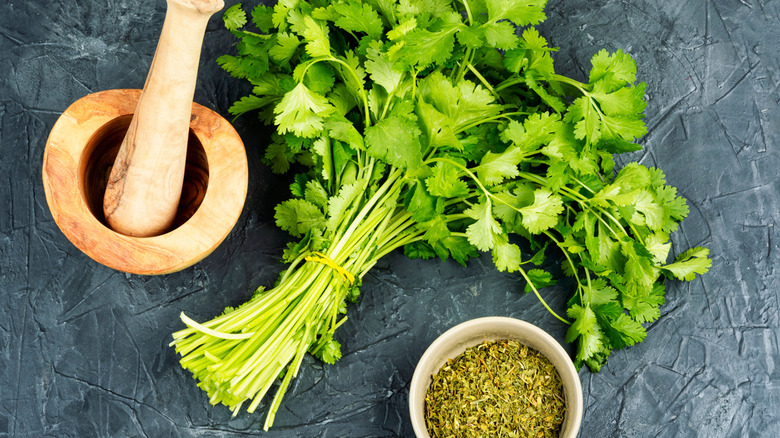The Important Tip To Remember When Substituting Dried Cilantro For Fresh
Fresh cilantro is an extremely useful herb. With its perky notes of citrus and a touch of pleasant bitterness, as well as its verdant visual flair and aromatic qualities, it's a mainstay in Mexican favorites (like your classic five-ingredient pico de gallo), as well as Asian and Caribbean cuisines — among others.
There are moments, however, when you just can't get your hands on a bundle of the fresh stuff. The good news is that if you have some dried cilantro on hand in the pantry, you can easily swap this version into your recipe in a pinch — but it's important to know how much to use.
Although some dried herbs are a one-to-one exchange for their fresh counterparts, dried cilantro should be used in less abundance. In fact, you'll want to cut the amount by half of whatever your recipe calls for in terms of fresh cilantro (for example, ½ cup dried versus 1 cup fresh). So while you can always aim to store cilantro so that it stays fresh, understanding how to use the dried version can help you keep your meal plan on track.
Making dried cilantro, and other swaps
You can purchase dried cilantro or even make your own when you have some fresh (in the oven at a low temperature, a dehydrator, or in open air). That said, keep in mind that even with this ratio tip, dried cilantro may not be ideal for all applications. The powdery texture probably won't work for your chimichurri or salsa verde, for example. Instead, try it out in a sauce or salad dressing, mixed into Greek yogurt for a topping or dip, or into a hearty chili along with spices like garlic, ginger, and chile pepper.
If you need to exchange your cilantro for another herb, dill, mint, and oregano all work well, as does tarragon (which adds a subtle licorice flavor). Given that they're related, parsley is a reliable go-to — especially if you pair it with a little citrus (juice or zest). There are some less expected options, too. Although cumin is a seed and not an herb, it is also a relative of cilantro (in the parsley family), so you might find success with this substitution. Chives and scallions can contribute to a dish in place of cilantro as well.
Some of these swaps can also be useful if someone in your life simply hates cilantro (perhaps because of the perceived soapy character). But if you want to stick to this herb, knowing the dried to fresh exchange rate is a dish saver.

